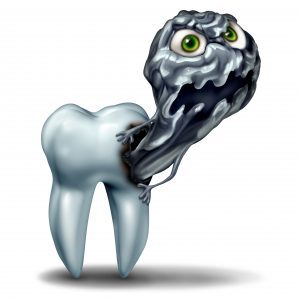Since childhood, you’ve been hearing about the infamous character called the ‘cavity.’ This monstrous little creature has the ability to multiply and wreak major havoc, but you’re not sure what his origin is and what drives his destructive tendencies. Your dentist in San Diego has been studying this matter very closely and is willing to share 5 facts about the notorious cavity. He’ll also explain how to defeat it with simple hygienic practices and preventive dentistry. Read on to learn more.
What is a Cavity?
A cavity is a hole that the acidic residue of bacteria and plaque can bore into your teeth. The main source of sustenance for these bacteria is sugar and leftover food particles in your mouth. And the acids that they release as they grow burn holes into the enamel on your teeth.
Once the enamel is damaged, it can’t miraculously grow back. It can only be repaired. This process involves removing the damaged surface and any bacteria in that area, and then filling the cavity to stop the intrusion into the inner parts of your tooth.
5 Facts About Cavities
Now that you know what a cavity is and what causes it, let’s look at 5 other rare facts about it:
- Tooth-Colored Fillings – Many people aren’t aware that there are now tooth-colored fillings available as an alternative to the traditional amalgam (made from a mixture of metals) fillings. With the tooth-colored option, you are able to address a cavity without losing the natural look of your teeth.
- Cavities Get Worse – Cavities don’t just go away. Once they start working, they don’t stop until your enamel is repaired. As long as they are allowed to do damage, they absolutely will. And if ignored, they will lead to more serious problems.
- Root Canal – One of the restorative methods that you may need if you allow a cavity to fester too long, is a root canal. At this point, you’ll be experiencing substantial pain from the cavity boring to the root of your tooth and infecting the pulp, the part that houses the nerves. This procedure will remove the infected tissues, clean, fill and seal the tooth.
- You May Need a Dental Crown – In some cases, the damage from the cavity may be so substantial that you won’t have enough enamel left to repair. Your dentist may recommend a dental crown as a remedy.
- Dental Fillings aren’t Permanent – Just so you can temper your expectations, it’s important to know that dental fillings aren’t permanent. This is because the bond between the enamel and the filling begins to weaken over time. When you see signs of this, you’ll simply visit your dentist to have a new procedure done, but note that your fillings will typically last for 7 to 10 years
How to Avoid Cavities
The best way to avoid cavities is to uphold the twin pillars of oral health – hygiene and semi-annual visits to your dentist. The following explains why the two are so important:
- Oral Hygiene – Oral Hygiene, which includes brushing and flossing your teeth at least twice a day, removes the harmful bacteria and food particles that contribute to cavities.
- Semi-Annual Dental Visits – Six-month visits to your dentist allow you to get a thorough cleaning and detailed examination to monitor the condition of your oral health. This prevents a minor oral issue from becoming a major problem.
You have an amazing opportunity before you – a chance to be proactive and take the steps to protect your mouth, teeth and gums before cavities can sink their mad tentacles in to do damage. Contact your family dentist in San Diego today to start a new chapter of oral wellness in your life.
About the Author
Dr. Greg Friedman earned his dental degree from Washington University’s School of Dental Medicine, and then went on to participate in a one-year General Practice residency at Barnes Medical Center. He practices at Mod Squad Dental and can be reached for more information through his website.




